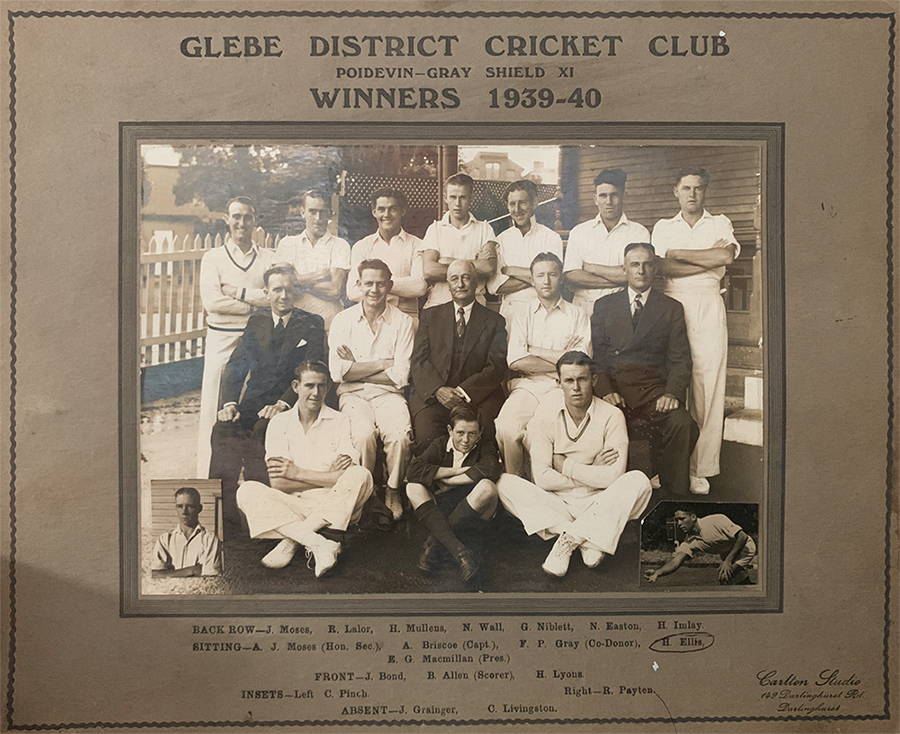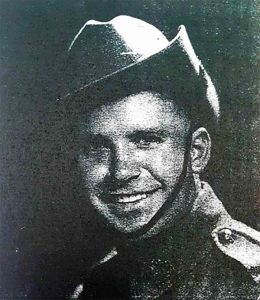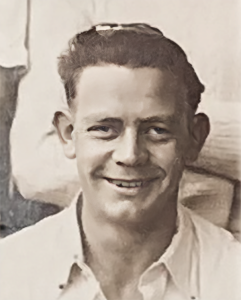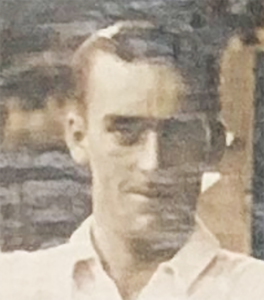By Rodney Hammett, Bulletin 9/2023, November
One of the rewarding aspects of receiving emails sent to the Glebe Society website, is that you never know what doors will be opened a little, and with a bit of research the door often flies wide open. Such was the case when Derice Harwood sent an email in November 2022, asking if we wanted a photograph that had been part of her stepfather’s cherished belongings. We are certainly interested, I replied.
As it turned out, her stepfather was Henry James Ellis, the vice-captain of the Glebe District Cricket team which won the Poidevin-Gray Shield in the 1939-40 season. The Poidevin-Gray Shield was established in the 1926-27 season, for clubs in the Sydney Cricket Association, for teams that were aged under 21. Sometimes they were referred to as ‘the juniors’. Glebe first won this shield in 1934/35, again in 1939/40 , then in 1958/59 and lastly as Glebe-South Sydney in 1964/65.
The photo duly arrived in January 2023, showing the bright young faces of the men of the Cricket Club. But there must have been some concerns behind those smiles as to what lay ahead. With World War 2 slowly gathering pace in Europe all would have heard the stories from their fathers or uncles of the rigours of World War 1.

The door opened a bit further as I tried to discover the stories of each person in the photo. I was able to discover the stories of 12 of the 19. Of the 12, ten enlisted for World War 2: Army (8), RAAF (1) and Merchant Navy (1). Each one of these survived the war to pursue a wide range of occupations post-war, including clerk, manager, labourer, poultry farmer, rigger, customs agent, supervisor, waterside worker, hotel keeper and a cricketer at State level. Many went on to live long lives, although one died aged only 43.

Henry James Ellis (1921-2006) was born in Leichhardt. He was the only surviving son of WW1 veteran Harry Ellis. His parents had married in August 1920. Harry was a Balmain boy; he enlisted in October 1915 then fought in France and Belgium where he received a gunshot wound in August 1916 and two further wounds in 1917. As a consequence of his gunshot wound, Harry’s right arm was amputated, following which he was repatriated to Sydney. Back in civvies, he became eligible for a pension of £3 a week – not much for losing your right arm!
The burden of life became too much for Harry and he took his own life in 1926. His son Henry and his mother settled in Glebe living in Derwent Street, and cricket became one of young Henry’s passions. For his day job, Henry was an engineer in the merchant navy.
Derice Harwood explained that Henry was in the coastal shipping trade, often sailing to Western Australia where he met his future wife, Valma Walker, in Perth. He served as an engineer on HMAS Kanimbla then became the Chief Engineer for the BP tankers in Australian waters, a job he held until he retired. Henry and Valma married at the Wayside Chapel, Sydney, on 15 September 1969, after which they returned to Perth to live. Denice remembers Henry as a wonderful husband for her mother and a delightful step-grandfather to all of Valma’s own grandchildren. He never lost his love of cricket. He and Valma were members of the WACA for many years where they watched cricket whenever they could.
Henry was diagnosed with cancer in 2003 and died in 2006, aged 85.

Roland Hugh Payten (1919-1995) Born at Rose Bay on 24 July 1919, he grew up on Lord Howe Island where his father was a farmer. Roland (Ron) had learned lawn bowls from his father and uncle from an early age and became the Island champion in 1937 while only 18. He happened to be on holiday in Sydney during the early part of the 1939-40 cricket season and played for Glebe where he contributed as a bowler (4 for 40 against Manly) and as a batter. His photo and story were the subject of a number of Sydney newspaper articles in November of 1939.
Enlisting as a Private in the Australian General Hospital in August 1941, Ron found himself in Singapore when the Japanese captured the island in February 1942. Then followed three and a half years of hell as a prisoner of war first in Changi Prison in Singapore then on the infamous Burma-Thailand railway. He was lucky to survive, but he did, returning to Australia in late 1945. Like many of the survivors, he didn’t like to talk about his experiences.
Welcomed back to Lord Howe Island, he followed in his father’s footsteps as a farmer. Ron married Hazel Amelia Retmock there in November 1946. It must have been an ideal life after his war experiences, no doubt he enjoyed a few games of bowls and cricket along the way. He lived until April 1995 when he died aged 75. Hazel lived until 2018 when she died at age 93. It is not known if they had a family. (Image: Ancestry)

Alfred Samuel Briscoe (1919-1988) and his sister Lorna (1920-1986) were the children of longtime Glebe residents Alfred Charles Briscoe and Lillian Grace (nee Quigley) who lived at 78 Mitchell Street. Alfred senior was the motor driver who in November 1929 lost control of his truck while driving in Bridge Street, crashing into a telegraph pole which snapped off and fell across the roof of a house.
Alfred junior was the captain of the cricket team. In August of 1940, not long after this photograph was taken,he enlisted in the Army where he became a private in the Eastern Command General Details Depot which was based at the Sydney Cricket Ground. This was a transit camp for troops moving to and from leave and for those passing through Sydney en route to or from different theatres of war. Alfred was discharged early in August 1942 then in October 1942 married Mary Margaret (Molly) Grant. The couple moved into 27 Broughton Street, Glebe and started their family. The family moved from Glebe in the late 1960s to live in Penshurst.
Alfred died at the age of 68 in 1988 but Molly lived on until 2006, aged 85. They had a son, Alfred John who married in 1971 and lived close by in Penshurst with his wife and children.

Robert Thomas Lalor (1922-1965) was the eldest child of Robert Alexander Lalor and Ethel Margaret (nee Dixon) who had married at St John’s Anglican Church, Glebe on 10 September 1921. Robert junior was born in1922.
Robert senior had a difficult childhood. At the age of 11 he was a delinquent and sent to the reform ship Sobraon moored in Sydney Harbour, which provided religious instruction, moral, industrial, and nautical training, as well as elementary schooling. Robert was there from February 1908 until April 1910. Upon his discharge his record states ‘bright and fairly intelligent’.
The Lalor family lived in Glebe. Robert senior worked as a labourer and linesman. The family moved frequently, presumably to find affordable housing and a suitable house for a growing family. During the 1930s they lived at 6 Jarocin Avenue, 12 John Street, 15 Forest Street and 44 Mount Vernon Street.
Robert junior, the cricketer, enlisted for World War 2 soon after this photograph was taken, understating his age by three years. He joined the newly formed 2/9 Field Regiment which began training at Holsworthy, NSW, before being sent to the Middle East in April 1941. Following Japan’s entry into the war, Australian troops were brought back, the 2/9th returning in March 1942. Initially they undertook defensive duties in southeast Queensland, then in 1943 were sent to Merauke in Dutch New Guinea where they remained until October 1944. At the time of Robert’s discharge in October 1945 he had attained the rank of Sergeant. He then lived with his parents who had moved to Narara near Gosford. Robert married Elaine Pearl Bryant in Gosford in 1946.
Robert and Elaine settled at Narara near his parents, and he described his occupation in the 1949 electoral roll as a poultry farmer, then in 1958 as a foreman. Robert died in 1965 at the age of 43.
Elaine remarried in 1968 to another WW2 veteran (John Rae) and they continued to live in the Gosford area for many more years. She died in 2010 aged 84.

Harry Gladstone Lyons (1919-1986) was born in Lewisham to teenager parents Harry James Lyons and Bertha Isabel Mutton whose marriage foundered soon after he was born. Harry junior was their only child. Bertha’s father, 20 years older than her mother, disappeared in 1911 and a warrant was issued for his arrest for desertion. The women of the family were able to keep the family housed and fed, and in 1930 the Mutton/Lyons family was living in Glebe, first at 5 Wigram Road and then at 15 Allen Street. Bertha was a dressmaker.
Growing up in Glebe, Harry would have played in Federal Park and been drawn to the cricket at Jubilee Oval. The railway viaduct nearby was a place where children went to play and see the games – in May 1932, 6-year-old Barry Morris of Avona Avenue fell off the viaduct some 17 metres to the ground, from which he suffered concussion, facial abrasions and a fractured and dislocated arm.
Harry married Olene Sofie Knudsen at St John’s Church, Glebe, on 21 February 1942 and then in July enlisted for WW2, joining the Australian Army Medical Corps (AAMC). By the end of the war Harry was part of the AAMC Beach Group which played a critical role in supporting the troops as they mopped up the Japanese resistance scattered through the islands of current-day eastern Indonesia. At the end of the war and prior to his discharge in January 1946, Harry had risen to the rank of Warrant Officer, Class 2.
Returning to Glebe he joined his wife, mother and grandmother who were still living at 15 Allen Street. Earlier, Harry and Olene had a son, born in 1943 who, however, died soon afterwards. Further children now followed through to the mid-1950s and the family then moved to Lalor Park where Harry worked as a rigger. His mother died in 1967 aged 65 and his maternal grandmother Eliza Harriet Mutton (nee Wilcox) died in 1969, at the age of 93. Olene predeceased him in 1985 aged 65 and Harry died in 1986 aged 67.
(All Images with the exception of Roland Payten supplied by Darice Harwood)









There are no comments yet. Please leave yours.